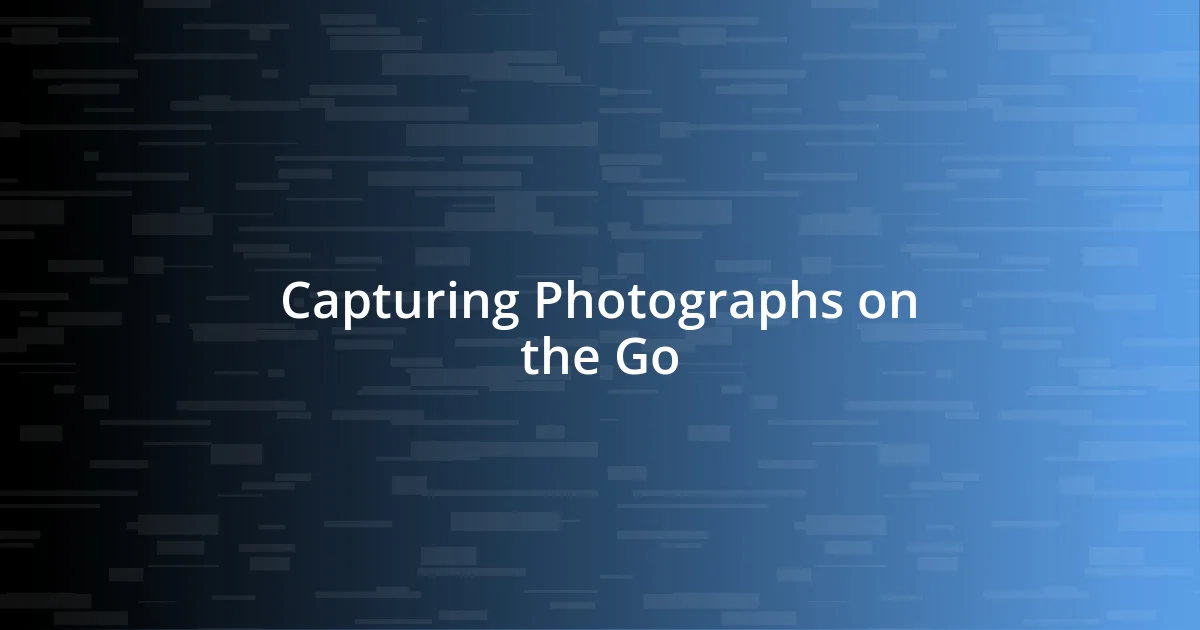Key takeaways:
- Choosing the right travel journal enhances the experience by considering size, paper quality, and personal connection.
- Essential travel gear includes a camera, journal, tripod, portable charger, waterproof pouch, and a comfortable backpack for optimal documentation.
- Engaging narratives in travel journals incorporate vivid details, emotions, and questions to connect with readers and transform experiences into compelling stories.

Choosing the Right Journal
Choosing the right journal can truly enhance your travel experience. I remember when I finally invested in a leather-bound journal during a trip to Italy; the tactile feel of the pages against my fingers made me want to write more. Have you ever felt that connection with a journal? It’s as if the right one invites your thoughts to spill out freely.
Consider the size of the journal, too. I once carried a bulky notebook on a hike in the Swiss Alps, and it was a constant struggle to find space for it in my pack. A compact, lightweight option would’ve made it so much easier to jot down my thoughts while marveling at those breathtaking views. What do you think would work best for your travel style—something portable or a more spacious choice for detailed entries?
Don’t forget about the paper quality. I’ve had experiences where I used gel pens on thin paper, only to find it bled through and marred my entries. It was frustrating, and it made me appreciate the thicker, high-quality paper in my current journal. Have you ever experienced something similar? A well-chosen journal creates not just a repository for memories but a beautiful canvas that holds the essence of your travels.

Gathering Essential Travel Gear
Gathering essential travel gear is about finding the perfect balance between functionality and inspiration. The excitement I felt when I chose my first travel camera is something I’ll never forget. It wasn’t just about capturing images; it was also about documenting my journey in a way that felt authentic. Since then, I’ve learned that having the right gear can make all the difference in how I experience a trip.
Here’s a list of essential items that I always pack:
- Camera: A DSLR or mirrorless camera for high-quality photos.
- Travel Journal: Something compact where I can sketch or jot down thoughts quickly.
- Lightweight Tripod: Perfect for those early morning shots or night skies.
- Portable Charger: Keeps my devices powered up, especially during long days out.
- Waterproof Pouch: To protect my gear from unexpected rain or spills.
- Comfortable Backpack: It should fit all my essentials while being easy on the back.
Each piece of gear contributes to a richer storytelling experience, whether I’m capturing sunsets on a beach or the sound of bustling markets. I’m always amazed at how these tools enable me to relive my adventures long after the journey ends.

Capturing Photographs on the Go
Capturing photographs on the go requires a blend of spontaneity and preparation. I always keep my camera easily accessible, often slinging it over my shoulder or attaching it to my backpack. There’s nothing quite like the thrill of spotting a stunning street scene or a breathtaking landscape and being able to snap the moment without fumbling through my bag. Have you ever missed a perfect photo opportunity because your camera was packed away? It’s a feeling I’ve experienced too many times, which motivated me to make my gear readily available.
One thing I’ve learned is to embrace the unexpected. During a hiking trip in the Rocky Mountains, I stumbled upon an impromptu gathering of mountain goats. I had only moments to catch the scene before they bounded away. Fortunately, I was ready and managed to capture a few incredible shots. That day reaffirmed the importance of being alert and prepared. After all, the best moments often come when we least expect them.
Lastly, consider lighting. Natural light is your best friend when capturing on-the-go photographs. I remember waiting for the golden hour while traveling through the streets of Barcelona. It was magical, as the city transformed under the warm glow of sunset. The photos I took during those moments still bring back vibrant memories. Do you have a favorite time of day for photography? Knowing your light can elevate your images from ordinary to extraordinary.
| Aspect | Importance |
|---|---|
| Camera Accessibility | Having your camera ready helps catch spontaneous moments. |
| Preparedness | Being ready enables capturing unique, fleeting experiences. |
| Natural Light | Good lighting enhances the quality and mood of your photos. |

Writing Engaging Travel Descriptions
Writing engaging travel descriptions is more than just detailing where I’ve been; it’s about weaving emotions into my narratives. I remember standing in front of a breathtaking waterfall in Iceland, feeling the cool mist on my face. It wasn’t enough to just note its height or location; I wanted to convey the exhilaration and sense of awe that washed over me. How can I make a reader feel as if they’re right there beside me, experiencing that moment? By sharing vivid details and my genuine emotions, the descriptions gain life.
When I write about a bustling market in Marrakech, I immerse my readers in the sensory experience. I might describe the vibrant colors of spices stacked high, the sounds of merchants calling out their wares, and the rich, spicy scent of street food wafting through the air. This approach not only helps paint a picture but invites readers to join me on my journey, making them feel part of the adventure. Have you ever felt the urge to travel just by reading someone else’s vivid descriptions? That’s the power of good writing.
Moreover, I find that asking questions in my travel narratives sparks curiosity. While describing a serene beach at sunrise, I might ask, “Have you ever watched the world wake up, painting the sky with colors you didn’t think existed?” This connection pulls the reader in, encouraging them to reflect on their own experiences. The goal is to create a shared moment, where they can envision themselves on that beach, feeling the soft sand beneath their toes. By blending personal anecdotes with thoughtful questions, the journey transforms from mere description to an engaging story waiting to unfold.

Organizing Your Travel Photos
When it comes to organizing travel photos, I swear by the concept of tagging and folders. After a trip to Japan, I spent a lazy afternoon categorizing my photos into folders by location and theme. It was cathartic, almost like reliving each moment. Do you ever find that going through your photos helps you reconnect with your travel experiences? I certainly do, and it makes me appreciate those fleeting moments even more.
I’ve also discovered the power of digital tools. Using apps like Google Photos not only allows me to store my images securely but also lets me create albums based on specific trips or events. I remember last summer’s road trip through the Pacific Northwest. Creating a shared album with friends generated excitement as we all added our favorite shots. The thrill of reminiscing together on those memories was priceless, don’t you think?
Lastly, I can’t stress enough how essential it is to back up your organized collections. After losing some treasured photos from a trip to Greece because of a hard drive malfunction, I learned my lesson the hard way. Now, I ensure that every photo is backed up in multiple locations. I genuinely believe that preserving those captured memories is just as important as taking them in the first place. How do you safeguard your own travel treasures?

Designing a Visually Appealing Layout
Designing a visually appealing layout for my travel photo journals transforms them from simple collections into immersive experiences. I like to use a grid system, balancing photos with text to create flow. For instance, during my trip to Italy, I organized my pages so that a striking image of the Amalfi Coast sat next to a heartfelt memoir about the gelato shop where I found joy in every single bite. This immediately draws the reader in and encourages them to linger over each page, don’t you think?
Color coordination is also a key aspect of my layout process. I often find that certain colors evoke specific feelings. After visiting the vibrant streets of Jaipur, I chose a warm palette for the photos, pairing deep pinks with soft golds to mirror the essence of the city. Each page became a work of art that not only showcased my photos but also reflected my emotional journey through those places. Have you ever considered how colors can shape the mood of your own travel journal?
Lastly, I think about the pacing of the layout. I mix long-form narratives with small snippets to keep the reader engaged. For instance, I vividly recall experiencing the serene beauty of Japanese gardens and pairing that with brief quotes that echo the tranquility I felt. This technique offers a rhythmic experience that allows readers to pause, reflect, and absorb rather than just gloss over the visual aspects. Isn’t it fascinating how the layout can enhance the storytelling aspect of our travels?

Sharing and Preserving Your Journal
Sharing my travel photo journal with others is one of the most fulfilling parts of the process. I remember sitting down with my family after a two-week trip to Costa Rica, flipping through the pages together. The collective joy and laughter as we recounted our adventures made me realize how these moments strengthen our bonds. Have you ever shown your travel memories to someone and relived those experiences together? It’s a special connection.
Preserving these journals is just as critical. I’ve learned to use both physical and digital methods. For my printed journals, I’ve found that using acid-free materials keeps the pages intact without yellowing over time. Digital backups, however, offer a safety net I refuse to overlook. A few years back, a water leak almost ruined my cherished Florida journal, but I was fortunate enough to have scanned every page beforehand. I can’t stress enough how important it is to consider both options. How do you balance your preservation methods?
Lastly, creating a community around your travel stories can enrich your experience. I often share my journals in workshops or with friends who have a mutual love for exploration. The conversations that spring from sharing these stories often lead to new friendships or even travel tips for future adventures. Isn’t it exhilarating to think that your memories could inspire someone else’s journey? Engaging others with my experiences enhances their value for me, reminding us all that travel is not just about the destination but the shared stories along the way.














